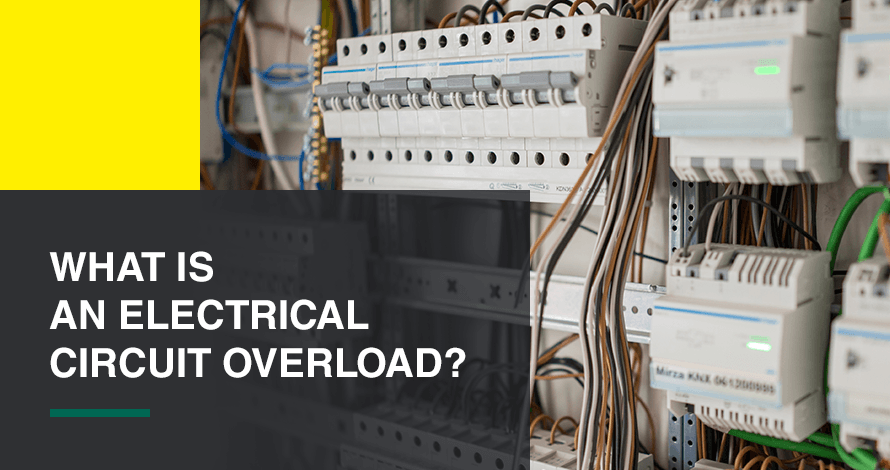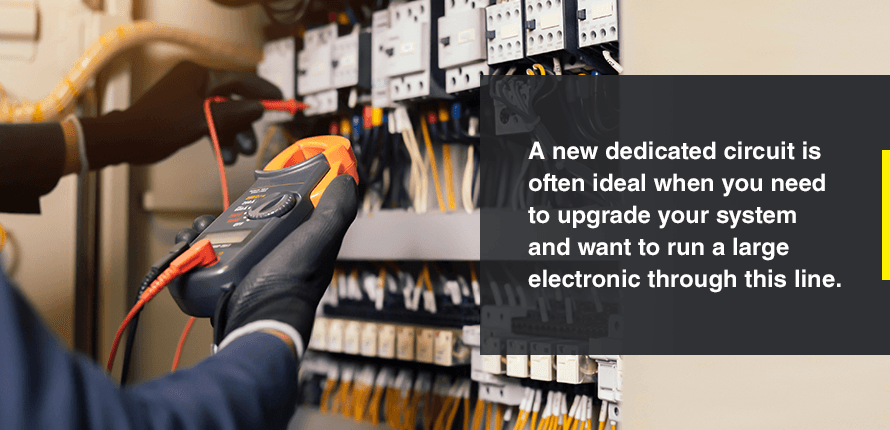
An overloaded circuit occurs when more electricity than your circuit can handle is introduced to the system. An electrical circuit has a safety feature to prevent circuit overload that cuts off electricity at a dangerous level. When overload protection is triggered, the circuit breaker trips and opens, cutting off the power supply to the unit.
Learn more about what happens when you overload a circuit and how to prevent a circuit overload.
What Are the Signs of an Overloaded Circuit?
To prevent and minimize the risk of an overloaded circuit, you should learn the various signs of a potential electrical overload. Another important step is to learn which circuits power what areas and devices of your home. If your living room lights dim when you turn the television on, it’s likely they’re on the same circuit, which may be close to maxing out the power load.
The visible health of wall plates and outlet covers is a strong indicator of a potential overload. While outlet covers are designed to protect you from the electrical wiring within, they can only withstand a certain amount of heat.
Should you notice that your outlet covers begin to discolor, crack or show other signs of damage, it’s often an indicator of an electrical overload. If you notice scorch marks around an outlet cover, you should immediately contact a professional to assess your electronics and ensure there is no dangerous electrical overload.
While the most obvious sign of a circuit overload is when a circuit breaker trips, other indicators can be present. Some signs of an overloaded circuit include:
- Flickering or dimming lights, especially when using other lights or appliances
- A buzzing sound from switches or outlets
- Switch covers or outlets that are warm to the touch
- Visible burn marks or a burning smell from switches or outlets
- Scorched outlets
- Sluggish electronics or lack of power in appliances
- A shock or tingling sensation when you touch switches, outlets or appliances
Is an Overloaded Circuit Dangerous?
Any electrical complications in the home can be dangerous and increase the risk of a circuit overload or house fire. While circuits that continually pop or turn off can be annoying, they’re also incredibly dangerous to your home and loved ones.
Unfortunately, a circuit overload is a leading cause of potential house fires. Research has found that residences are the leading property type for fire-related deaths (72.2%), fire dollar loss (46.4%) and fire injuries (76.4%).
A house fire can cause property damage, personal injury and even death in severe cases. Because a circuit overload can be dangerous and increase the risk of house fires, it’s essential to understand the potential warning signs of an overloaded circuit.
Understanding circuit best practices and how to minimize the risk of a circuit overload can keep you, your loved ones and your home safe. While not a threat, circuit overloads can also cause electronics to be less powerful and reliable, which can be frustrating.
Even when an overloaded circuit doesn’t cause a house fire immediately, it can still damage your home. For instance, you may notice scorched, melted or burnt outlet covers or structures near the outlet. This property damage can be frustrating and expensive to repair while greatly increasing the risk of a house fire.

How to Prevent an Electrical Circuit Overload?
Avoiding a circuit overload can be achieved by ensuring the appropriate electrical load travels through a circuit. In simplest terms, avoiding an electric overload means you should not plug too many electronics into the same circuit and use them simultaneously.
In most cases, each room will have a dedicated circuit, helping you understand when a circuit may be experiencing an electric overload. Note that large or heavy-duty appliances and electronics may require their own line to minimize the risk of a circuit overload.
- Upgrade circuits: If your circuits can’t meet your electrical demands, you may want to consider upgrading your circuits or adding another circuit. A new dedicated circuit is often ideal when you need to upgrade your system and want to run a large electronic through this line.
- Calculate circuit load: Generally, a circuit is rated between 15 to 20 amps. Calculate the circuit load by determining how much current the appliances and lights on a circuit need to operate. Calculating your circuit load helps you know what’s a safe number of appliances to use on a specific circuit and can help minimize the risk of an overload. If you’re reaching your circuit’s maximum load, you may want to consider using an appliance or two on a different circuit.
- Be aware of larger electronics: If you have a room with many larger appliances, such as the kitchen or laundry room, you should be mindful of the electrical load on the circuits. These circuits may be more likely to overload. In rooms that use larger electronics, you may want to make a habit of unplugging any electronics or devices you don’t plan to use regularly, freeing up some space for the circuit.
- Consider LEDs: If you can’t minimize the electrical load, you may want to consider light-emitting diodes (LEDs). LED lightbulbs are a great alternative because they require significantly less current than traditional lightbulbs need, saving you money and reducing the risk of a circuit overload.
What Device Protects a Circuit From Overload?
A few key devices can protect a circuit from an overload, including:
Circuit Breaker
A circuit breaker is an electromechanical device that can open one or more ungrounded circuit conductors when a fault occurs. Circuit breakers use a bi-metallic strip and thermal action to prevent potential overload. A magnetic sensing coil helps protect against a possible overcurrent situation. One main benefit of circuit breakers is you can reset them.
Fuse
Another way to protect a circuit from an overload is a fuse, a simple device that protects equipment and circuit conductors from damage from elevated fault values. A fuse is an insulated tube that houses a strip of conductive metal known as fuse-link, which can have a lower melting point than aluminum or copper.
A fuse link has resistive, narrow segments designed to concentrate the current, causing the temperature at those specific points to rise. During a circuit overload, the elements of the fuse will react and burn within a few seconds or minutes.
There are two types of fuses, including time-delay fuses (type d) and fast-acting fuses (type p).
Protect Your Home With an Electrical Safety Inspection
At Wiretech Company, our experts can provide a comprehensive electrical safety inspection to assess your home’s electrical system and ensure it meets safety standards. All of our team members are experts in electrical safety and are dedicated to ensuring your home is safe.
Learn more about our electrical safety inspections and schedule your inspection today.

